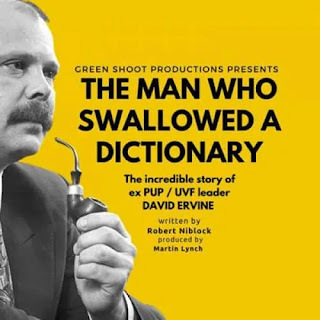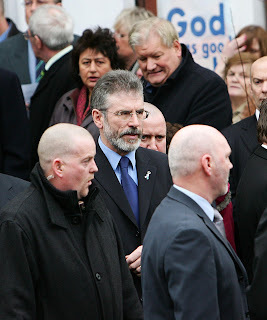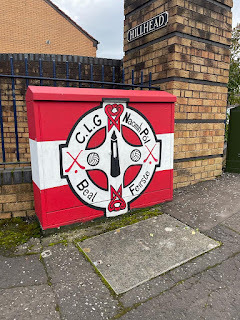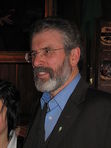David Ervine - The Man Who Swallowed A Dictionary: Street Art: Mól An Óige.
David Ervine - The Man Who SwallowedA Dictionary
Anyone who knew David Ervine or knowsof him will appreciate the title of Bobby Niblock’s play - The Man WhoSwallowed A Dictionary. In its humorous description of David’s style ofspeaking and wordiness it reminds us of a political leader who was an able anddetermined advocate for working class loyalism. His sudden death in January2007 at the age of 53 left a political vacuum within loyalism and widerpolitics which has never been properly filled.The Progressive Unionist Party which David led has failed to garner the popularpolitical support that it was once thought capable of under hisleadership.
I have not yet had an opportunity tosee Bobby’s play but friends whohave thoroughly enjoyed the one-man show.They praised the script and actor Paul Garrett who successfullybrings the nuances and David’s voice to life on the stage with just twolarge books, a bushy moustache and a pipe as his props.
During the course of the negotiationsleading to the Good Friday Agreement and in the years afterward I met Davidmany times. Among otherthings we were both pipe smokers. He was also articulate, genuine, and deeply committed to his brand ofunionism. He had a goodsense of humour. He was very socialable. In Kerry in support of the projectinvolving young people from East Belfast to build a replica ofThe Jeanne Johnson - a ship used during the Great Hunger to transport starving Irishto America - David and Martin Ferris would often adjourn to alocal pub to scull pints and chat about sport.
But healso had no illusions about thechallenges facing all of us as we worked to chart a course from conflict topeace. While the Ulster Unionist leaders refused to talk to Sinn Féinthroughout the negotiations leading to the Good Friday Agreement David and his colleagues played no such games.
An east Belfast working-classProtestant David Ervine was drawn into the loyalism at an early age. In 1972 hejoined the UVF and two years later he was imprisoned in Long Kesh forpossession of a bomb. David spent five and a half years there. When he wasreleased he was more politically and socially conscious. He wasself-assured, confident and argued for greater positivity and dialogue withinunionism. In the discussions that were taking place in the 1990s about movingfrom conflict into some sort of peace and political process David’s voice, alongwith Billy Hutchinson and others, became increasingly important andinfluential within the protestant/unionist/loyalist (PUL) community.
He often criticised unionistpolitical leaders for using loyalist paramilitaries, and the threat of loyalistviolence, as leverage in their confrontations with the British and Irishgovernments, and who then discarded them when they no longer mattered. “Ifanybody in Northern Ireland thinks that the Protestant working class communityhas benefited from the mechanisms that they [the DUP] advocate, then there issomething wrong with their heads.” Two decades later and this dangerousgame is still being played although it has to be said many loyalistgroups go along with this despite being conscious of being used by unionistparties.
On another occasion talking aboutsectarianism he said: "Many people come from places where drawing-roomsectarianism is at its worst … and they have luxuriated and benefited associety, divided more and more, crashes on the rocks." It is a greatpity that today’s loyalists don’t see the folly of this. They continue to allowthemselves to be used.
In an interview with Danny Morrisonin 2002 David acknowledged that the conflict had its origins in the North’sone-party unionist state and the discrimination levelled against Catholics. Ata time when the issue of Irish Unity wasn’t attracting the interest it is todayDavid said that he would “accept a united Ireland if a majority in the Northvotes for it.” His preference of course was to make the North work foreveryone. His thoughts on what motivates unionism are probably more relevanttoday than they were 20 years ago when the current momentum toward Irish Unitywas not so strong.
He told Danny: “You’ve got tounderstand how unionism works. There is a huge insecurity within unionism.Unionism really hasn’t had time to settle. They feel that the republicanagitation is never going to stop. The one thing that unionists lust for isstability. It’s the one thing they have never had.”
At David's Funeral
Later he said: “I am what I am. I amboth Irish and British but I’m a democrat too… There’s nothing more fascistthan someone telling you what you are, especially if you perceive yourself tobe somewhat different… We are steeped in concepts of Britishness… but those whoare the legal arbiters are the people of Northern Ireland. It is absolutelylegitimate for republicans to argue the validity of a united Ireland but thenew dispensation is worthy and there should be no Plan B. My mother and fatherwere Irish, my grandparents, and very simplistically so. But there are argumentsabout the haunting mist of the 1937 Constitution that forced the unionistpeople to re-think their Irishness.”
If he were still with us we couldhave a good debate over some of this. But nonetheless today we increasingly seeprotestant/unionist voices embracing the notion of being Irish and of equalityand parity within the context of constitutional change. If David were here nowhe would be in the middle of this conversation, smoking his pipe andadvocating his views.
His sudden death in January 2007 was ashock. Alex Maskey and I attended his funeral in East Belfast. It was anopportunity to let his wife Jeanette know how much David was respected and ofour sincere gratitude for the immense contribution he made to the peace processand to the Good Friday Agreement.
Street Art.
When I had the honour to represent the fine citizens of Louth and East MeathRichard and I spent a lot of time in Dublin. In between marathon shifts inTeach Laighean we used to walk the streets of the capital. Both of us were taken by theinitiatives to paint utility fittings like electric boxes with images of localor national figures, pithy slogans, landscapes, iconic landmarks and abstract designs.
Drab grey metal was transformed intobright eye catching and mind lifting street art. Now I see this is beingreplicated in Belfast. Naomh Pól and Rossa are leading the way. Very well done.Let’s see other clubs doing their thing. And images also of local people orflora and fauna or relics of the linen industry or butterflies, locallandmarks and local art.
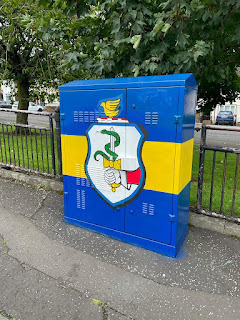
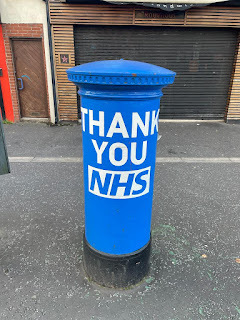
Mól An Óige.
If you are in Belfast between nowand November 9 call into the Gerard Dillon Gallery in AnCultúrlan McAdam Ó Fiaich on the Falls Road and marvel at the brilliance of theyoung students of Coláiste Feirste. Fair play to them all and to theirteachers. The future is bright. They are a valued and wonderful part of thearts and wider community. A credit to themselves, their families, to Belfastand Ireland. Mol an óige agus tiocfaidh sí
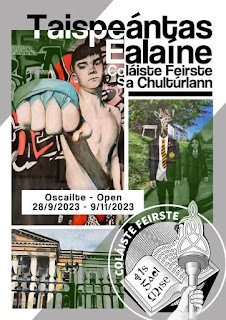
Gerry Adams's Blog
- Gerry Adams's profile
- 29 followers


